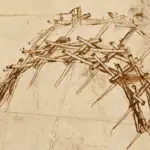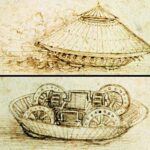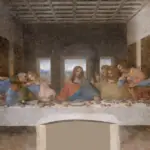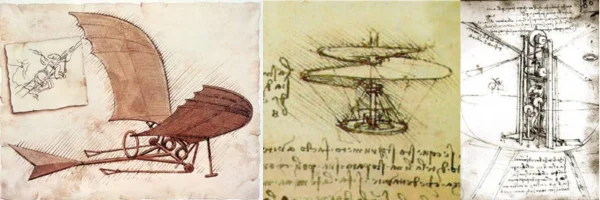
Leonardo da Vinci flying machine has captivated the imagination of historians and aviation enthusiasts. Despite his drawings and designs, the machine was never capable of flight.
Da Vinci created several designs that showed his deep interest in human flight. His most notable idea was the ornithopter, which aimed to mimic the flapping of bird wings. Still, these designs required materials and technology not available in his time, ultimately preventing them from being realized.
The mystery of the flying machine continues to intrigue people today. By examining historical records and expert analyses, you can gain a clearer insight into da Vinci’s unfulfilled dream of flight.
His innovative spirit and vision paved the way for future inventors and left a lasting impact on the world of aviation.
The Concept of the Leonardo da Vinci Flying Machine
Leonardo da Vinci was a visionary thinker known for his inventive genius.
His flying machines, especially the ornithopter, highlighted his understanding of animal flight and his determination to mimic it. Though unsuccessful, these inventions paved the way for future aviation developments.
Understanding the Ornithopter Design
The ornithopter is one of Leonardo da Vinci’s most intriguing designs. It was inspired by birds’ flight and involved wings that flap like birds’.
Da Vinci’s sketches showed a meticulous design that harnesses human power and aerodynamic principles. The wings were to be controlled by a system of pulleys and levers, allowing the pilot to simulate the flapping motion.
This design illustrated his profound interest in human flight and his desire to replicate nature’s efficiency in flying. His notes reflect a deep understanding of motion and mechanics, although the machine was ultimately non-functional due to the limitations of human strength.
Early Flying Machines: Da Vinci’s Inventions
Leonardo da Vinci’s contributions to early flying machines showcased his remarkable creativity and insight. Among his numerous designs, the ornithopter stands out, but he also explored other concepts.
These included a helicopter-like device with a helical rotor intended to lift off through rotational force. Though visionary, the helicopter Leonardo da Vinci flying machine was not feasible at the time due to the lack of suitable materials and propulsion technologies.
Despite their impracticality, his designs are celebrated for their imaginative engineering and lasting impact on aviation.
The Evolution of Da Vinci Flying Machines
Over time, Da Vinci’s flying machines evolved with increasingly complex designs. He went from simple sketches to more advanced concepts, hoping to achieve sustained human flight.
Each design iteration incorporated feedback from previous models and experiments. Leonardo da Vinci’s flying machine reflected observations of nature and mechanical innovation.
Da Vinci’s machines never took to the skies but were a foundation for subsequent inventors. His work inspired others to continue exploring the dream of flight, contributing significantly to the history of aviation technology.
Leonardo da Vinci’s Approach to Aviation
Leonardo da Vinci’s approach to aviation was groundbreaking. He blended art and science in a way that set the foundation for future innovators.
His sketches and observations on bird flight translated into detailed designs for mechanical flights.
Leonardo da Vinci and Flight: A Visionary’s Perspective
Leonardo da Vinci viewed flight as a symbol of freedom and limitless human potential. His fascination with birds and their ability to soar inspired him to study their anatomy closely.
Leonardo created detailed drawings to capture the mechanics of wing motion. This meticulous research was artistic and scientific, aimed at replicating avian flight through machines.
His vision extended beyond sketches, reflecting a deep understanding of how nature can guide technological advances.
The Role of Leonardo da Vinci’s Flying Machine Sketches
Leonardo da Vinci’s flying machine sketches, often called ornithopters, featured large wings designed to flap like a bird.
These sketches explored various forms, including a helicopter-like device with a screw-shaped rotor. Though they were never built or tested in Leonardo’s lifetime, these designs illustrated his forward-thinking approach to human flight possibilities.
Leonardo’s sketches demonstrated his ability to envision machines centuries ahead of his time, influencing later aviation concepts.
Analyzing the Leonardo da Vinci Plane Design
The Leonardo da Vinci plane design showcased his engineering brilliance by attempting to mimic the complex dynamics of bird flight. His designs included a lightweight frame combined with firm, flexible wing surfaces.
Despite advances in understanding aerodynamics, the technology of the era couldn’t materialize such sophisticated designs. While the machine was theoretical, it represented a crucial step in the history of aviation.
His work displayed an early understanding of the principles behind lift and propulsion, which are central to modern aviation engineering.
The Mechanics Behind the Flying Machine
Leonardo da Vinci’s flying machine, an ornithopter, is one of his most famous inventions. This impressive design uses human muscle power to mimic the flapping of bird wings, showcasing Leonardo’s innovative approach to aerodynamics and mechanics.
How to Make a Leonardo da Vinci Flying Machine Model
Building a model of the da Vinci flying machine provides insight into the mechanics he envisioned. The model often requires lightweight materials such as wood or plastic to simulate the rod-and-pulley system that powered the original design.
Simplified versions focus on the large wings essential to its operation. These wings are connected via cranks and levers, allowing flapping motion. Enthusiasts can find kits online or at hobby stores that include detailed instructions for assembly, enabling a hands-on experience with one of history’s earliest flying machines.
The Science of the Da Vinci Airplane
The science behind Leonardo da Vinci’s airplane centers on the principles of lift and propulsion.
Leonardo’s sketches detail ornithopters, which aim to achieve flight by flapping wings, much like birds. His designs, such as the flying machine, explored methods to harness human power to create lift.
By translating muscle movement into mechanical action through a series of gears and pulleys, Leonardo aimed to replicate bird flight. Although his machines never took flight, they laid foundational ideas to inspire future aviation developments.
Insights from Leonardo da Vinci’s Flying Machine Drawings
Leonardo da Vinci’s drawings of flying machines show his remarkable understanding of flight. His sketches often included detailed annotations on wing shape and movement.
These plans reveal Leonardo’s belief in human flight and his desire to emulate the natural grace of birds. The drawings depict a keen observation of bird anatomy, focusing on elements like wings that are adjustable and contorted for different phases of flight.
His meticulous attention to detail is a testament to his genius, inspiring artists and engineers.
Leonardo da Vinci’s Innovative Landing Gear Design
Leonardo da Vinci’s landing gear design, part of his broader exploration of flight, introduced the concept of retractable landing gear for aircraft.
This remarkable invention demonstrated his forward-thinking approach to aviation safety. It allowed for a more controlled landing by utilizing a mechanism that could be retracted or deployed as needed.
Historical Context and Impact of da Vinci Flying Machine
Leonardo da Vinci’s flying machine was a groundbreaking concept for its time, showcasing his deep interest in human flight and mechanical innovation. This section explores when the flying machine was invented, examines its feasibility, and considers its impact on modern aviation.
When Was the Flying Machine Invented by Leonardo da Vinci?
Leonardo da Vinci began exploring the idea of flight during his stay in Milan in the late 15th century. His fascination with aviation is evident in his collection of sketches and notes.
The most notable of these is the ornithopter, a concept that attempted to mimic the flapping of bird wings. The da Vinci flying machine inventions included around 500 sketches, demonstrating his dedication to understanding flight mechanics.
His designs featured intricate systems of pulleys, gears, and wings that reflect his innovative approach to human flight. Though these machines did not achieve liftoff, they inspired future generations of inventors to pursue the dream of air travel.
Did Leonardo da Vinci’s Flying Machine Work?
Despite Leonardo’s ingenious designs, the flying machine never achieved flight. The materials available in his time were unsuitable for constructing a functional aircraft.
Da Vinci’s models required a strong yet lightweight frame, which technology couldn’t provide then. His interest in bird anatomy and aerodynamics was crucial in guiding his ideas, but his era’s practical limitations were insurmountable.
Though his machines remained grounded, Leonardo da Vinci’s concepts of flying machines laid foundational thoughts in aerodynamics and engineering for future innovations.
The Legacy of Leonardo da Vinci’s Inventions in Aviation
Leonardo’s work significantly impacted aviation history. His sketches and theories inspired countless inventors and engineers in the following centuries.
The aerial screw, regarded as an early form of the helicopter, showcases his forward-thinking approach. Many believe his ideas influenced later aviation pioneers, including those who developed the first successful aircraft.
Da Vinci’s work on flying machines emphasized creativity and scientific inquiry, underlining the importance of innovation in technological development. Today, his contributions are celebrated as pivotal steps toward realizing human flight, reflecting his enduring influence on aviation.
Modern Interpretations of Leonardo da Vinci Flying Machine
Leonardo da Vinci was ahead of his time with his visionary ideas on flight. Although his flying machines never took off during his lifetime, they have influenced modern aviation technologies and inspired countless innovations.
The Influence of Leonardo da Vinci’s Flying Machine on Contemporary Aviation
Leonardo da Vinci’s designs for flying machines, like the ornithopter, have sparked imagination and innovation in aviation.
His meticulous studies of bird movement informed his sketches, which show a deep understanding of aerodynamics, a fundamental concept in modern flight.
Though his designs were not practical during his time, they laid the groundwork for future developments.
Today, scientists and engineers look back at his work for inspiration in creating new flying technologies. Some projects, like modern flying cars, draw from da Vinci’s ideas.
His influence can be seen in various experimental aircraft that mimic the flapping motion of birds to achieve flight.
What Was Leonardo da Vinci’s Flying Machine Called?
The ornithopter is Leonardo da Vinci’s most famous flying machine design. This device was meant to be powered by human strength.
Leonardo envisioned a machine that could imitate the flight of birds through flapping wings. While his ornithopter did not become a working model, it captured his curiosity about flight.
Leonardo da Vinci created around 500 drawings and sketches detailing his theories on aviation. These designs played a critical role in the early stages of aerodynamics.
The ornithopter, in particular, left a lasting legacy symbolizing human ambition to conquer the skies.
The Ingenious Design of Leonardo da Vinci’s Parachute
Leonardo da Vinci’s parachute design, created around 1485, featured a pyramid shape that allowed a person to descend from great heights safely. Although it was never tested during his lifetime, modern experiments have shown that his concept was surprisingly effective, highlighting his visionary understanding of aerodynamics.
Final Thoughts
Leonardo da Vinci Flying Machine holds a unique place in aviation history. His inventive designs and curious sketches reveal a mind dedicated to understanding flight, even though the technology of his time was not advanced enough to bring his concepts to life.
Many of Leonardo’s ideas were not practically feasible, but his work has inspired countless inventors and engineers. His flying machine, mainly the Grande Nibbio, showcased an imaginative approach to mimicking bird flight through mechanical means.
There have been debates on whether Leonardo’s designs could ever work. Some believe that with modern materials, his concepts might take flight. However, experts often argue that his machines were more like art than workable engineering solutions.
Key Takeaways:
- Leonardo’s flying machine was too advanced for his time.
- His visionary ideas paved the way for future innovations in aviation.
Leonardo da Vinci’s legacy continues to inspire exploration in various fields.
Frequently Asked Questions
Leonardo da Vinci’s flying machine remains a topic of interest. People often wonder whether it could fly, who first invented flying machines, and what impact these inventions had.
Did Leonardo da Vinci’s flying machine work?
Leonardo da Vinci’s flying machine, known as the ornithopter, was never tested by him, so it did not work during his time. The concept involved flapping wings like a bird, but technological limitations and human strength made it impractical.
Who invented the first flying machine?
Leonardo da Vinci designed some of the earliest concepts for a flying machine. However, the Wright brothers achieved the first successful powered flight centuries later, in 1903.
Was Leonardo da Vinci able to fly?
Leonardo da Vinci himself did not fly. Although he had ideas about human flight, his designs were never tested in a way that achieved actual flight during his lifetime.
Did the ornithopter ever fly?
With its flapping wings, the ornithopter faced challenges in practicality and human strength requirements. While fascinating, it did not achieve successful flight in Leonardo’s or any later iterations.
How did the flying machine impact the world?
Leonardo’s flying machine concepts inspired future generations in the field of aviation. His ideas showed an early interest in human flight and significantly contributed to aeronautical engineering history.
What does Leonardo’s sketch of a flying machine mostly reveal?
Leonardo’s sketches reveal his keen interest in observing nature and understanding flight. They highlight his skill in blending art with engineering to explore new ideas.
Did Leonardo’s aerial screw work?
Leonardo’s aerial screw is an early design similar to a helicopter’s rotor. Like many of his inventions, it was never built during his time, and it likely wouldn’t have flown due to material and structural limitations.
What was Leonardo da Vinci’s best invention?
Determining Leonardo da Vinci’s best invention is subjective, but his designs ranged from the Vitruvian Man to military engineering. The Vitruvian Man remains one of his most iconic drawings.
Did Leonardo da Vinci’s parachute work?
Leonardo da Vinci designed a parachute concept different from the traditional canopy design. It was successfully tested in modern times and proven to work.
What was Leonardo da Vinci’s misconception about flight?
Leonardo’s main misconception was the reliance on mimicking bird flight using human muscle power. This approach overlooked the need for powered flight mechanisms. These were only realized centuries later.

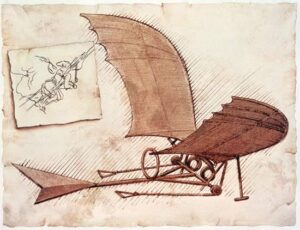
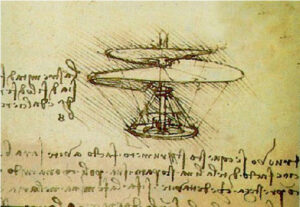
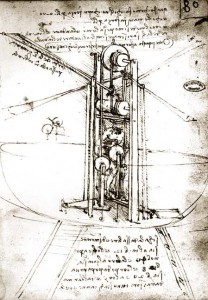

 I’m Leonardo Bianchi, the mind behind Leonardo da Vinci's Inventions. Thanks for visiting.
I’m Leonardo Bianchi, the mind behind Leonardo da Vinci's Inventions. Thanks for visiting. 